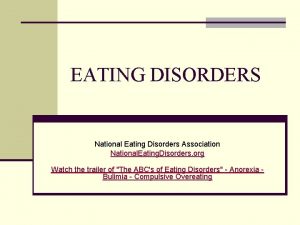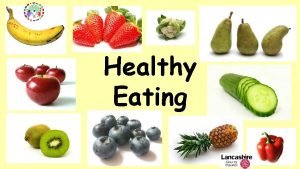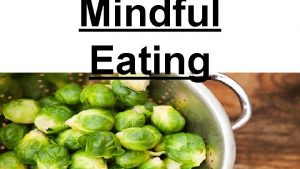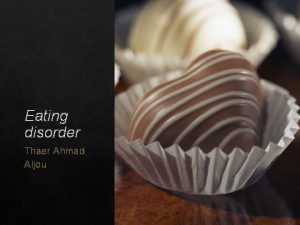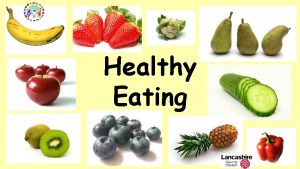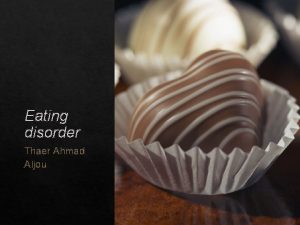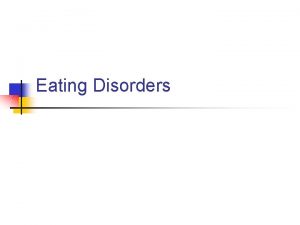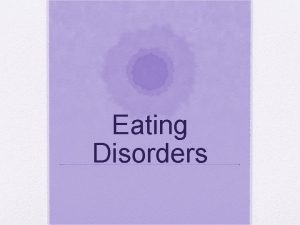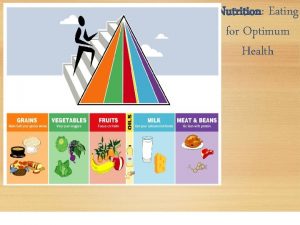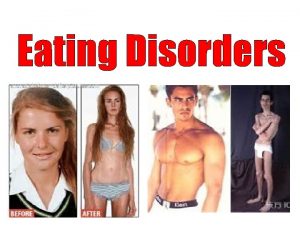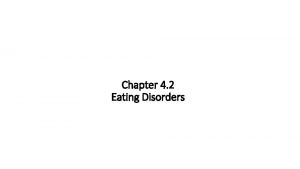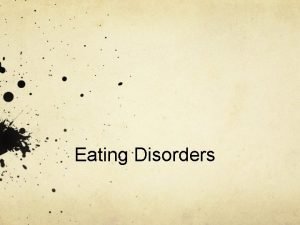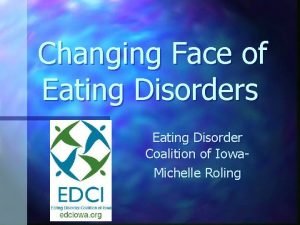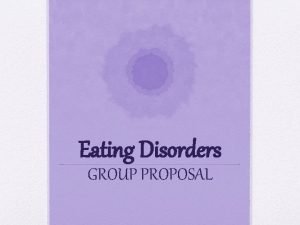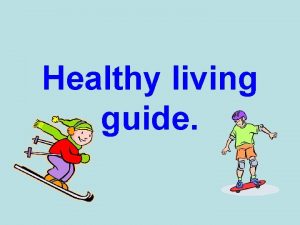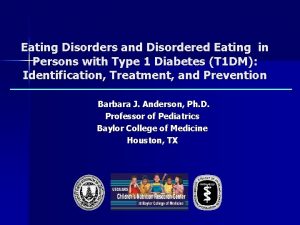EATING FOR HEALTH Welcome to Eating for Health


















































- Slides: 50

EATING FOR HEALTH

Welcome to Eating for Health • Presentation will discuss: • Diet and health, strategies and tips for change and healthier eating • Questions in the chat box • Please ask questions as we go • Privacy Tips

Who Am I? • Introduction • A little about the presenter

Outline �Dietary fats and processed foods ◦ Unsaturated ◦ Saturated fat ◦ Trans fat ◦ Triglycerides ◦ Processed foods �Fibre �Salt �Plate method �Physical activity and stress management �Action plan for change and problem solving steps

Terms A) Cholesterol B) Blood pressure C) LDL cholesterol D) HDL cholesterol E) Triglycerides (TG) ____Not a type of cholesterol but a fat found in the blood ____“Lousy, Bad” - high amounts in the blood promotes build-up of plaque in the artery walls ____ How much pressure in your blood pushes against your artery walls ____ “Happy, Good” – Helps carry LDL-cholesterol away from artery walls ____ A waxy, fat-like substance found in all cells of the body

Target Cholesterol Levels – High Risk • Total cholesterol < 5. 2 (less than 4. 0 with Diabetes) • HDL > 1. 0 (men) > 1. 3 (women) • LDL < 2. 0 • Triglycerides < 1. 5 • Ratio < 4. 0

Terms • Cholesterol - One of the fats in blood • High blood cholesterol is a risk factor for heart disease and stroke. Lowering your cholesterol can reduce your risk. • Blood Pressure - The measure of how much pressure your blood is pushing against your artery walls. • Low risk: 120/ 80

Terms “Lousy, Bad” cholesterol. It promotes the build-up of plaque in the artery walls. • LDL – • HDL – “Happy, Good” cholesterol. It helps carry LDL-cholesterol away from the artery walls.

Terms • Triglycerides (TG) are not a type cholesterol but a fat found in the blood. • TG levels relate to sugar and alcohol intake in the diet

DIETARY FAT AND PROCESSED FOODS • Why do we need dietary fats? • Types of fats and health effects • Processed foods

Why We Need Dietary Fats? • Dietary fats provide energy to the body and helps with normal body functions • TYPE vs AMOUNT is important

Types of Fat • The type of fat we eat is important because it can affect the cholesterol levels in your body • Unsaturated fats = “good”, protects us from heart disease • Saturated and trans fats = “bad”, increases risk for heart disease.

Types of Fat: Unsaturated Fat • Replace saturated and trans fats with unsaturated fats to: • Help improve our cholesterol levels • Lower heart disease risk

Types of Fat: Unsaturated Fat • Ways to include unsaturated fat • Use teaspoon size amounts of olive, canola or peanut oil in cooking and baking • Choose salad dressing and soft margarines made with vegetable oils more often • Snack on small amounts of dry roasted, unsalted nuts • Use peanut/nut butters instead of butter

Unsaturated Fats: Omega 3 Fats • Omega-3 fats are heart healthy • Helps prevent blood from sticking and clotting, lowers cholesterol and triglycerides • There are three kinds of omega-3 fats: ALA, DHA, EPA

Unsaturated Fats: Omega 3 Fats • Ways to include Omega 3 fatty acids • Enjoy 2 -3 fish meals each week using fresh, canned or un-battered frozen fish • Sprinkle ground flaxseed on cereal, yogurt, oatmeal • Add walnuts or pumpkin seeds to a salad, yogurt or baked goods • Replace regular eggs with omega-3 eggs • Use flaxseed, canola or soybean oil on salads or when cooking or baking

Types of Fat: Saturated Fat • Intake of saturated fat increases LDL-cholesterol and total cholesterol

Types of Fat: Saturated Fat • Where does the majority of saturated fat in the North America diet come from? • Processed foods: • Cakes, cookies, donuts • Ice cream • Pizza, cheese

Types of Fat: Trans Fat • Increases LDL-cholesterol and decreases HDL- cholesterol • Trans fats have been linked with up to a 10 x higher risk of heart disease

Types of Fat: Trans Fat • Avoid foods with “partially hydrogenated", "hard margarine” and “shortening” on the ingredient list • Buy foods with zero trans fat • Look at labels for cookies, pies, snack foods, microwave popcorn to choose lower fat. Reduce fried foods

Lowering Triglycerides: Sugar and Alcohol • Triglyceride levels in the blood relate to sugar and alcohol intake in the diet • Sugary foods and alcohol increase triglyceride levels, increasing cardiovascular risk

Types of Fat: Highly Processed Foods • Major source of saturated fats, calories, sodium free sugars and potentially trans fat • Diets that include highly processed foods lead to the development of heart disease and stroke

Fibre • Fibre is the part of food from plants that we do not digest • Can help lower LDL-cholesterol and has other health benefits • Daily recommended intake: 25 – 38 g/day

Fibre: 2 Types Insoluble: Acts like a sponge in intestines Helps prevent constipation • Whole grains • Fruits, vegetables Soluble: Forms a gel in intestines Helps control blood sugars 10 g/day decreases LDL • Oats, barley, • Flax, chia, psyllium • Pulses


How can I get more fibre in my diet? • Choose breads, bagels, pitas, tortillas and wraps with 2 -4 g fibre/serving • Start your day with a high fibre cereal that has 4 g fibre/serving • Use whole wheat pasta or brown rice instead of white pasta/white rice • Add vegetables/salad to your lunch and dinner meal • Bring vegetables and low fat dip as a snack to work • Add fresh berries to yogurt or cereal • Have fruit for dessert • Add lentils or beans to soups, casseroles and salads • Add ground flaxseed to cereal, oatmeal or yogurt • Have a small handful of nuts as a snack

SALT • Salt (Sodium) is a mineral that is found naturally in foods, table salt, and processed foods. • Adults and children get 2 x the amount needed • Too much salt in our diet increases blood pressure which over time can lead to kidney disease, heart issues, or stroke.

Salt Where do we get the most salt from in the diet? • Naturally occurring in foods: ____% • Added to food during cooking or at the table: ____% • Restaurant/processed foods: ____%

Salt How much salt should I be eating? • Minimum intake per day • Maximum intake per day • Avg Canadian intake per day

Salt: How much salt should I be eating? Minimum per day = Maximum per day = Canadian intake per day = • ½ tsp = 1200 mg • 1 tsp = 2300 mg • 1 ½ tsp = 3400 mg

Salt To prevent hypertension aim for a sodium intake around 2000 mg per day

Salt How do I tell if a food I am eating has a lot of salt in it?

Salt How do I tell if a food I am eating has a lot of salt in it? • Follow the streetlight method: • 0 -200 mg per serving Green light- Go ahead • 200 -400 mg per serving Yellow light- Watch out • 400+ mg per serving Red light- Too much

Salt: Using % Daily Value (%D. V. ) • Less than 5%: Best and the recommended level for people with high blood pressure • Less than 6 -14%: Okay • Above 15%: Watch out

Salt: Green light, Yellow Light, Red Light?

Green Light 0 -200 mg Yellow Light 200 -400 mg Red Light 400 mg+

Green Light 0 -200 mg • 1 apple = 2 mg • ½ cup vegetables = 6. 8 mg Yellow Light 200 -400 mg Red Light 400 mg+ • 2 slices of white bread = 340 mg • 1 Package of ramen noodles = 2000 mg • Tuna = 320 mg • 2 dill pickles = 1080 mg • 4 slices of bacon = 820 mg • 1 tbsp soya sauce = 880 mg

Salt Tips What are some ways we can reduce our salt intake? • Limit canned foods • Limit salted snack foods and fast foods • Use only small amounts of marinades/condiments

Plate Method: Putting it all Together Benefits to using Plate Method: • feeling satisfied • balanced meals • portion control


What About Your Meals?

Putting it all Together

Stress Management Breathing Exercise • Chronic stress can lead to negative consequences • Important to intervene when feeling stressed • https: //www. youtube. com/watch? v=ICn. Skm. ZV 7 UE

Physical Activity • The benefits of exercise are tremendous • Aim for 150 minutes per week • https: //www. youtube. com/watch? v=3 F 5 Sly 9 JQao

ACTION PLAN FORCHANGE • What is a behavior you would like to change within the next 2 weeks? • Is your plan specific enough? How confident are you?

Make a SMART Plan What is the behavior you would like to change: _________________________________ Can it be achieved within 2 weeks? (Yes/no) __________ Is it specific? (What? How much? When? How often? ) _______________________________________________ How confident are you (on a scale of 1 -10)? ________(if you rate 7 or less go to Problem Solving – next slide) What would you need to increase your confidence? ______________________

PROBLEM SOLVING STEPS 1. Identify the problem 2. List ideas to solve the problems 3. Select one method to try 4. Check the results 5. Pick another method if the last one didn’t work 6. Try again!

Summary �Dietary fats and processed foods ◦ Unsaturated ◦ Saturated fat ◦ Trans fat ◦ Triglycerides ◦ Processed foods �Fibre �Salt �Plate method �Physical activity and stress management �Action plan for change and problem solving steps

Conclusion For more opportunities to learn, please check out our Group Program Guide: www. wrha. mb. ca/groups

Closing and Evaluation Thank you for participating! Evaluation – https: //www. surveymonkey. com/r/V 9 QWXBP If you wish to connect to a Registered Dietitian (RD), and know your clinic has one on staff, please contact them directly. Or if you are unsure, please email us at: nutritionandfoodservices@wrha. mb. ca Someone there will be able to help connect you to a RD in your area!
 Wise men three clever are we
Wise men three clever are we Formuö
Formuö Typiska drag för en novell
Typiska drag för en novell Nationell inriktning för artificiell intelligens
Nationell inriktning för artificiell intelligens Returpilarna
Returpilarna Varför kallas perioden 1918-1939 för mellankrigstiden
Varför kallas perioden 1918-1939 för mellankrigstiden En lathund för arbete med kontinuitetshantering
En lathund för arbete med kontinuitetshantering Personalliggare bygg undantag
Personalliggare bygg undantag Personlig tidbok för yrkesförare
Personlig tidbok för yrkesförare A gastrica
A gastrica Densitet vatten
Densitet vatten Datorkunskap för nybörjare
Datorkunskap för nybörjare Stig kerman
Stig kerman Debatt artikel mall
Debatt artikel mall Delegerande ledarskap
Delegerande ledarskap Nyckelkompetenser för livslångt lärande
Nyckelkompetenser för livslångt lärande Påbyggnader för flakfordon
Påbyggnader för flakfordon Tryck formel
Tryck formel Svenskt ramverk för digital samverkan
Svenskt ramverk för digital samverkan Urban torhamn
Urban torhamn Presentera för publik crossboss
Presentera för publik crossboss Vad är ett minoritetsspråk
Vad är ett minoritetsspråk Vem räknas som jude
Vem räknas som jude Treserva lathund
Treserva lathund Epiteltyper
Epiteltyper Claes martinsson
Claes martinsson Centrum för kunskap och säkerhet
Centrum för kunskap och säkerhet Byggprocessen steg för steg
Byggprocessen steg för steg Mat för idrottare
Mat för idrottare Verktyg för automatisering av utbetalningar
Verktyg för automatisering av utbetalningar Rutin för avvikelsehantering
Rutin för avvikelsehantering Smärtskolan kunskap för livet
Smärtskolan kunskap för livet Ministerstyre för och nackdelar
Ministerstyre för och nackdelar Tack för att ni har lyssnat
Tack för att ni har lyssnat Referatmarkering
Referatmarkering Redogör för vad psykologi är
Redogör för vad psykologi är Matematisk modellering eksempel
Matematisk modellering eksempel Tack för att ni har lyssnat
Tack för att ni har lyssnat Borra hål för knoppar
Borra hål för knoppar Vilken grundregel finns det för tronföljden i sverige?
Vilken grundregel finns det för tronföljden i sverige? R formel
R formel Tack för att ni har lyssnat
Tack för att ni har lyssnat Rita perspektiv
Rita perspektiv Informationskartläggning
Informationskartläggning Tobinskatten för och nackdelar
Tobinskatten för och nackdelar Toppslätskivling dos
Toppslätskivling dos Datumr
Datumr Egg för emanuel
Egg för emanuel Elektronik för barn
Elektronik för barn Antikt plagg i rom
Antikt plagg i rom Strategi för svensk viltförvaltning
Strategi för svensk viltförvaltning



















































